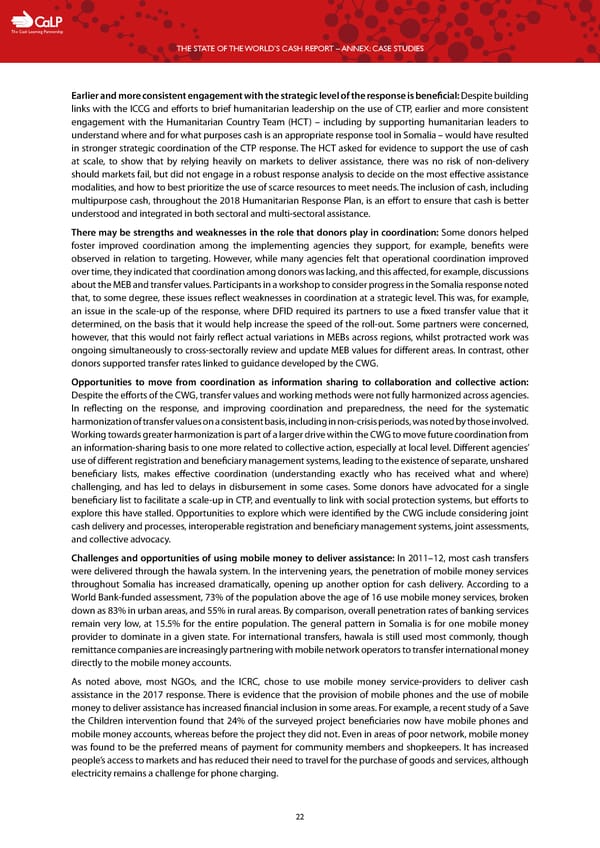C The Cash Learning Partnership THE STATE OF THE WORLD’S CASH REPORT – ANNEX: CASE STUDIES Earlier and more consistent engagement with the strategic level of the response is beneficial: Despite building links with the ICCG and efforts to brief humanitarian leadership on the use of CTP, earlier and more consistent engagement with the Humanitarian Country Team (HCT) – including by supporting humanitarian leaders to understand where and for what purposes cash is an appropriate response tool in Somalia – would have resulted in stronger strategic coordination of the CTP response. The HCT asked for evidence to support the use of cash at scale, to show that by relying heavily on markets to deliver assistance, there was no risk of non-delivery should markets fail, but did not engage in a robust response analysis to decide on the most effective assistance modalities, and how to best prioritize the use of scarce resources to meet needs. The inclusion of cash, including multipurpose cash, throughout the 2018 Humanitarian Response Plan, is an effort to ensure that cash is better understood and integrated in both sectoral and multi-sectoral assistance. There may be strengths and weaknesses in the role that donors play in coordination: Some donors helped foster improved coordination among the implementing agencies they support, for example, benefits were observed in relation to targeting. However, while many agencies felt that operational coordination improved over time, they indicated that coordination among donors was lacking, and this affected, for example, discussions about the MEB and transfer values. Participants in a workshop to consider progress in the Somalia response noted that, to some degree, these issues reflect weaknesses in coordination at a strategic level. This was, for example, an issue in the scale-up of the response, where DFID required its partners to use a fixed transfer value that it determined, on the basis that it would help increase the speed of the roll-out. Some partners were concerned, however, that this would not fairly reflect actual variations in MEBs across regions, whilst protracted work was ongoing simultaneously to cross-sectorally review and update MEB values for different areas. In contrast, other donors supported transfer rates linked to guidance developed by the CWG. Opportunities to move from coordination as information sharing to collaboration and collective action: Despite the efforts of the CWG, transfer values and working methods were not fully harmonized across agencies. In reflecting on the response, and improving coordination and preparedness, the need for the systematic harmonization of transfer values on a consistent basis, including in non-crisis periods, was noted by those involved. Working towards greater harmonization is part of a larger drive within the CWG to move future coordination from an information-sharing basis to one more related to collective action, especially at local level. Different agencies’ use of different registration and beneficiary management systems, leading to the existence of separate, unshared beneficiary lists, makes effective coordination (understanding exactly who has received what and where) challenging, and has led to delays in disbursement in some cases. Some donors have advocated for a single beneficiary list to facilitate a scale-up in CTP, and eventually to link with social protection systems, but efforts to explore this have stalled. Opportunities to explore which were identified by the CWG include considering joint cash delivery and processes, interoperable registration and beneficiary management systems, joint assessments, and collective advocacy. Challenges and opportunities of using mobile money to deliver assistance: In 2011–12, most cash transfers were delivered through the hawala system. In the intervening years, the penetration of mobile money services throughout Somalia has increased dramatically, opening up another option for cash delivery. According to a World Bank-funded assessment, 73% of the population above the age of 16 use mobile money services, broken down as 83% in urban areas, and 55% in rural areas. By comparison, overall penetration rates of banking services remain very low, at 15.5% for the entire population. The general pattern in Somalia is for one mobile money provider to dominate in a given state. For international transfers, hawala is still used most commonly, though remittance companies are increasingly partnering with mobile network operators to transfer international money directly to the mobile money accounts. As noted above, most NGOs, and the ICRC, chose to use mobile money service-providers to deliver cash assistance in the 2017 response. There is evidence that the provision of mobile phones and the use of mobile money to deliver assistance has increased financial inclusion in some areas. For example, a recent study of a Save the Children intervention found that 24% of the surveyed project beneficiaries now have mobile phones and mobile money accounts, whereas before the project they did not. Even in areas of poor network, mobile money was found to be the preferred means of payment for community members and shopkeepers. It has increased people’s access to markets and has reduced their need to travel for the purchase of goods and services, although electricity remains a challenge for phone charging. 22
 The State of the World's Cash | Case Studies Page 23 Page 25
The State of the World's Cash | Case Studies Page 23 Page 25